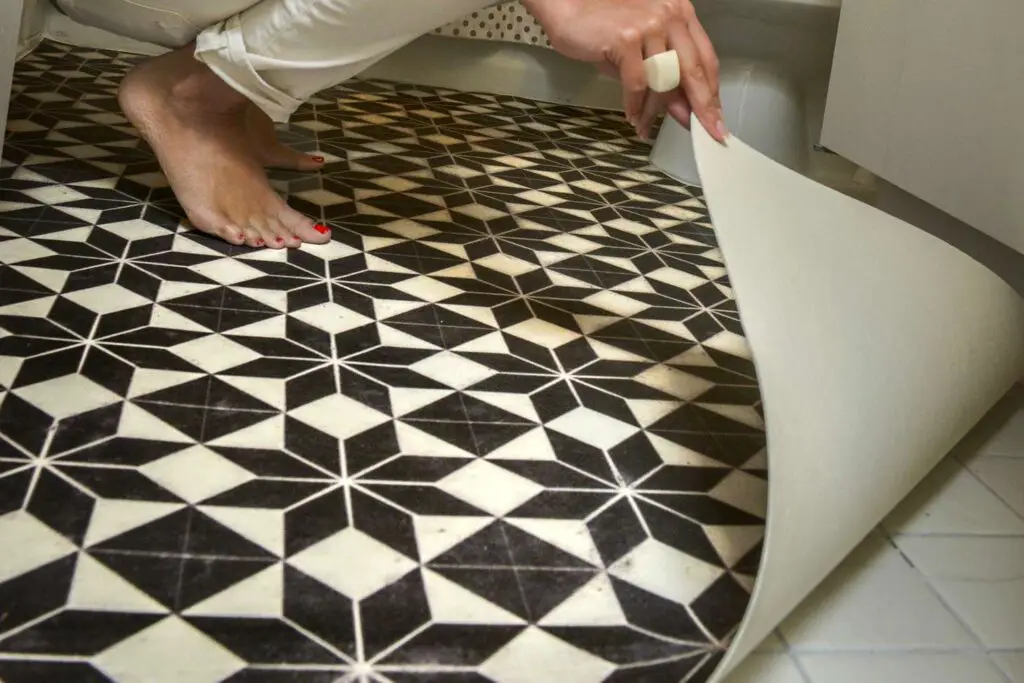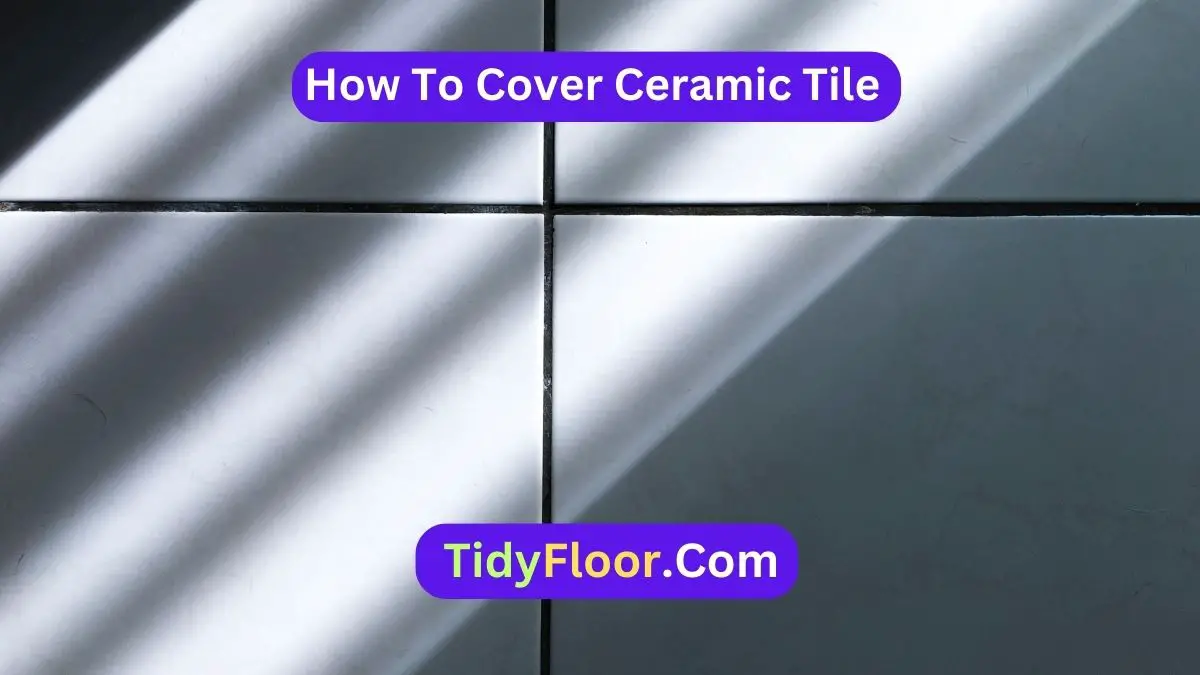Transforming the look of a room often involves recomposing its foundational elements. Ceramic tile offers durability but may lack the desired aesthetic. Fortunately, modern design presents an array of creative methods to refresh these surfaces. Discover how to cover ceramic tile for an appealing beauty if you’re looking for ways to do so.
To cover ceramic tile, explore options like peel-and-stick tiles, laminate flooring, epoxy coating, or tile overlays. Prepare the surface, choose the desired covering method, and follow installation instructions for a refreshed look without tile removal.
Throughout this guide, you’ll explore some best options to cover ceramic tiles. Also, you’ll learn some tips for choosing the right one.
8 Effective Ways To Cover Ceramic Tile:

Covering ceramic tile can be a great way to update the look of a space without the expense and hassle of removing the existing tile. Here are some effective methods to cover ceramic tile:
Way 1 – Vinyl Tile or Planks
Vinyl tile or planks offer a versatile and cost-effective solution for covering ceramic tile. These thin, flexible materials are easy to install directly over existing tile using adhesive, minimizing the need for extensive preparation or demolition. Vinyl comes in a wide array of styles, colors, and textures, including options that mimic the look of natural materials like wood or stone.
Its durability and water resistance make it suitable for various spaces, including kitchens, bathrooms, and basements. With proper installation, vinyl can provide a durable and attractive finish that refreshes the appearance of the room.
Way 2 – Laminate Flooring:
Laminate flooring is a popular choice for covering ceramic tile due to its affordability, durability, and ease of installation. Laminate planks typically interlock and float over the existing tile, eliminating the need for adhesive or extensive preparation. This makes it a relatively quick and straightforward DIY project.
Also, laminate flooring comes in a wide range of styles, including options that replicate the look of hardwood, tile, or stone. Its scratch and moisture resistance make it suitable for high-traffic areas like kitchens and living rooms.
With its realistic appearance and low maintenance requirements, laminate flooring offers a practical and attractive solution for updating ceramic tile surfaces.
Way 3 – Peel-and-Stick Tiles:
Peel-and-stick tiles provide a convenient and affordable option for covering ceramic tiles. These tiles come with adhesive backing, allowing them to be easily applied directly over the existing tile surface without the need for additional adhesives or grout.
Peel-and-stick tiles are available in a wide variety of materials, colors, and patterns, including options that mimic the look of ceramic, stone, or metal tiles. They are also durable and water-resistant.
So they are suitable for use in moisture-prone areas such as kitchens and bathrooms. With their versatility and ease of installation, peel-and-stick tiles offer a practical solution for updating the look of ceramic tile surfaces.
Way 4 – Epoxy Coating:
Epoxy coating provides a durable and seamless option for covering ceramic tile. This method involves applying a two-part epoxy resin directly onto the tile surface, creating a smooth and waterproof finish. Epoxy coating not only covers up the existing tile but also adds a layer of protection. Hence, it is ideal for high-traffic areas and environments prone to moisture, such as bathrooms and kitchens.
Before applying the epoxy coating, the ceramic tile surface needs to be thoroughly cleaned and prepared to ensure proper adhesion. This typically involves etching or sanding the tile surface to create a rough texture for the epoxy to grip onto. Once prepared, the epoxy is mixed and applied evenly over the tile using a roller or brush.
The epoxy coating comes in a variety of colors and finishes. Thus it allows for customization to match the desired aesthetic of the space. Also, additives such as metallic pigments or decorative flakes can be incorporated to create unique designs and textures.
Way 5 – Tile Paint or Stain:
Tile paint or stain offers a budget-friendly option for covering ceramic tile surfaces. This method allows you to change the color of the existing tile without the need for extensive demolition or replacement. Before applying the paint or stain, it’s essential to thoroughly clean and prepare the tile surface to ensure proper adhesion and longevity of the finish.
Tile paints are specially formulated to adhere to ceramic surfaces and typically come in a variety of colors and finishes, including gloss, satin, and matte. Stains, on the other hand, penetrate the tile surface to change its color while still allowing the natural texture of the tile to show through.
When applying tile paint or stain, it’s essential to follow the right instructions carefully and apply multiple thin coats for even coverage. Also, applying a clear sealant over the painted or stained surface can help protect it from wear and tear and enhance its durability.
Way 6 – Ceramic Tile Overlays:
Ceramic tile overlays offer a customizable solution for covering existing ceramic tile surfaces. These thin, lightweight tiles can be installed directly over the existing tile using adhesive, eliminating the need for extensive demolition or replacement. Ceramic tile overlays come in a variety of sizes, shapes, and patterns, allowing for endless design possibilities.
Before installing the overlays, it’s essential to thoroughly clean and prepare the existing tile surface to ensure proper adhesion. This may involve sanding or etching the tile to create a rough texture for the adhesive to grip onto. Once prepared, the overlays are applied using tile adhesive or mortar, similar to traditional tile installation methods.
One of the benefits of ceramic tile overlays is their ability to completely transform the look of a space without the expense and hassle of removing the existing tile. Whether you prefer a classic subway tile pattern or a more intricate mosaic design, ceramic tile overlays offer a versatile and customizable solution for updating ceramic tile surfaces.
Way 7 – Carpet Or Rug:
Covering ceramic tile with carpet or rugs offers a softer and more comfortable option, especially for areas where warmth and cushioning are desired. Carpet tiles are a practical choice as they can be easily replaced if stained or damaged, making them ideal for high-traffic areas. They come in various sizes, colors, and textures, allowing for customization to suit the aesthetic of the space.
Area rugs are another option for covering ceramic tile surfaces. They come in a wide range of sizes and styles, including traditional, contemporary, and vintage designs, allowing you to add warmth, texture, and visual interest to the space. Area rugs can be easily moved or replaced to change the look of the room or accommodate different furniture arrangements.
When selecting carpets or rugs for covering ceramic tile, it’s essential to consider factors such as durability, ease of maintenance, and compatibility with the existing decor. Also, using a non-slip rug pad underneath area rugs can help prevent slipping and sliding on smooth tile surfaces.
Way 8 – Concealing Ceramic Tiles Permanently:
Concealing ceramic tiles permanently can be a viable solution to update a space without major renovations. However, the choice depends on factors like durability, long-term plans, budget, and aesthetic preferences.
Considering these factors ensures the chosen method aligns with your needs, whether it’s painting, overlaying, or covering with alternative materials like vinyl or laminate. Proper installation and consideration of the space’s function are vital for a satisfactory, long-lasting outcome.
6 Tips To Choose The Right Strategy To Cover Ceramic Tiles:
Choosing the right strategy to cover ceramic tiles can transform the look and feel of a space. By considering a few factors, you can make an informed decision that suits your needs and preferences.
Tip 1: Check Durability And Lifespan
Consider the durability and longevity of each covering method. Evaluate factors such as the material’s resistance to wear, moisture, and stains, as well as its expected lifespan. Choose a covering method that aligns with the level of durability needed for the specific space and its intended use.
Tip 2: Look at Ease of Installation
Evaluate the complexity of installation for each covering method. Some options, like peel-and-stick tiles or carpet, may be easier to install as DIY projects, while others, such as epoxy coating or tile overlays, may require professional expertise. Consider your skill level and available time when selecting a covering method.
Tip 3: Think About What Looks Good
Consider your aesthetic preferences and the desired look for the space. Explore the range of colors, patterns, and textures available with each covering method. Choose a covering that complements the existing decor and enhances the overall aesthetic of the room.
Tip 4: Keep Your Budget in Mind
Factor in your budget constraints when choosing a covering method. Compare the costs of materials, labor (if applicable), and any additional tools or supplies needed for installation. Choose a covering method that provides the best value for your budget while still meeting your durability and aesthetic requirements.
Tip 5: Consider Maintenance Needs
Consider the maintenance requirements of each covering method. Some options may require regular cleaning, sealing, or refinishing to maintain their appearance and durability. Choose a covering method that aligns with your willingness and ability to perform ongoing maintenance tasks.
Tip 6: Think About Future Flexibility
Think about future flexibility when choosing a covering method. Consider whether the chosen covering can be easily removed or replaced in the future if your preferences or needs change. Select a covering method that allows for flexibility and adaptability over time.
Related Questions
Can You Cover A Cracked Ceramic Tile Without Replacing It?
You can cover a cracked ceramic tile without replacing it using several methods. One option is to use a peel-and-stick tile or vinyl plank specifically designed for covering existing tile surfaces. Alternatively, you can apply tile paint or stain to conceal the crack and refresh the tile’s appearance.
Another option is to use a ceramic tile overlay or epoxy coating to create a new surface over the cracked tile. Proper surface preparation is crucial for ensuring adhesion and a seamless finish when covering a cracked ceramic tile.
What Is The Average Cost To Cover Ceramic Tiles?
The average cost to cover ceramic tiles varies depending on factors such as the chosen covering method, the size of the area, and any additional materials or labor required. For example, options like peel-and-stick tiles or tile paint tend to be more affordable, with costs averaging between $1 to $5 per square foot for materials.
In contrast, more involved methods like epoxy coating or ceramic tile overlays may cost between $5 to $15 per square foot, including materials and professional installation. It’s essential to consider all costs, including preparation and maintenance when budgeting for covering ceramic tiles.
Can You Cover Ceramic Tiles Without Removing Them?
You can cover ceramic tiles without removing them using various methods. Options include applying peel-and-stick tiles, installing laminate flooring or vinyl planks over the existing tiles, using tile paint or stain to refresh the surface, applying epoxy coating for a durable finish, or using ceramic tile overlays to create a new surface. These methods offer a cost-effective and efficient way to update the look of ceramic tiles without the need for extensive demolition or replacement.
Final Verdict For How To Cover Ceramic Tile
Updating the appearance of a space often involves considering creative solutions that balance aesthetics, functionality, and budget. Whether opting for simple peel-and-stick tiles, elegant overlays, or durable epoxy coatings, the goal remains the same. With the right approach, covering ceramic tile opens the door to endless design possibilities and transformative results. Follow the approaches discussed above about how to cover ceramic tiles and enjoy a charming environment in your home.


